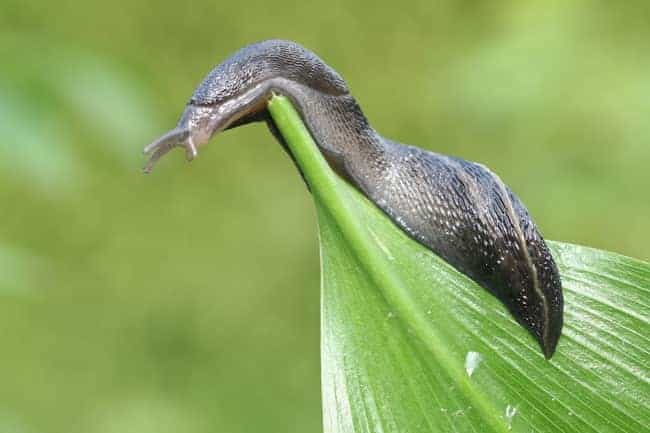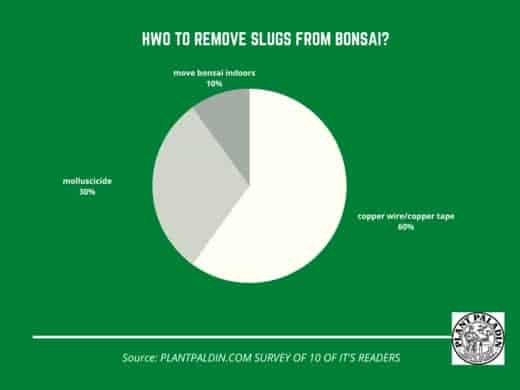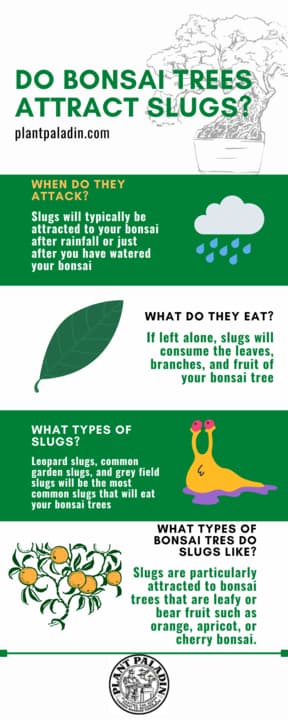This website is supported by its readers. If you click one of my links I may earn a commission. I am also a participant in the Amazon affiliates program and I will also earn a commission from qualified purchases.

So recently I’ve been growing some strawberries alongside my bonsai collection. Sadly however I’ve seen a huge influx in the number of slugs and snails in and around my strawberry plants. This got me thinking if strawberry plants seem to attract slugs. Do bonsai trees attract slugs too?
Dense, leafy tree species used for bonsai such as ficus, apple trees, and maples will attract slugs. This is because slugs and other mollusks like to feed on the leaves. To avoid, wrap copper wire around your bonsai trunk or on your bonsai bench.
Now slugs will tend to come out just after you have watered your bonsai during warm weather.
So how can you avoid slugs from feeding on your bonsai tree? And what bonsai species, in particular, attract slugs? Keep reading to find out more.
Just a quick heads up, over the past three years of running Plantpaladin, hundreds of people have asked for product recommendations. As such, You can find my favorite indoor bonsai tree here (link takes you to Bonsaiboy), my favorite outdoor bonsai tree (link takes you to Bonsaiboy), or have a look at all the products I recommend here.
Do bonsai trees attract slugs?
If you live in a temperate climate as I do in the UK, rainy but warm summers are commonplace.
Whilst these summers are fantastic for keeping bonsai, with you never really having to worry about your bonsai not being in the optimal temperature range, one sight all too familiar are slugs, snails, and other mollusks in and around our gardens.
Now bonsai trees are usually kept outdoors on benches (or bonsai greenhouses if you can afford them)
So do bonsai trees attract slugs?
Luckily I’ve visited a few garden centers, asked 10 plant paladin readers, and even had to deal with a few slug outbreaks myself – here are my findings.
- Bonsai trees can attract slugs during the summer months
- Slugs will typically be attracted to your bonsai after rainfall or just after you have watered your bonsai.
- If left alone, slugs will consume the leaves, branches, and fruit of your bonsai tree.
- As such slugs are particularly attracted to bonsai trees that bear fruit such as orange, apricot, or cherry bonsai.
- Slugs are also attracted to bonsai that have larger leaves or bonsai with more ramification.
- This is because there will be more leaves for them to eat.
- Leopard slugs, common garden slugs, and grey field slugs will be the most common slugs that will eat your bonsai trees.
How to deal with a slug infestation for your bonsai?
So now we know that bonsai trees, and especially leafy fruit-bearing bonsai can attract slugs, how can you deal with a slug outbreak?
To remove slugs and snails from your bonsai, wrap copper wire on the bottom of your bonsai trunk where it touches the topsoil. The copper wire will impact a slug’s nervous system and they will not be able to scale your bonsai.
Consider wrapping copper wire on the legs of your bonsai bench or around your bonsai pot to avoid slugs from getting anywhere near your tree.
Let’s explore this and some other methods for removing slugs below:
Keep an eye out where your slugs live
Most slugs will only be visible after watering your bonsai or after rainfall and so it’s important to try and locate them to understand the scale of your problem.
Keep an eye out in dark damp places in your garden (think the back of your shed or under rocks nearby your bonsai.
You might also want to check underneath your bonsai bench which I found to be a haven for a lot of slugs.
Move your bonsai indoors
Easily the first thing you should do if you are worried about your bonsai getting overrun with slugs or snails is to move your bonsai indoors.
You see most slugs, snails and mollusks hide in dark damp places during the day, mainly under rocks or other small spaces.
Slugs also travel incredibly slowly and so keeping your bonsai indoors means there is a much smaller chance of them attacking your tree.
Just ensure that if you do keep your bonsai indoors, that you pay extra close attention.
It can be a lot easier to underwater or overwater your tree keeping them indoors.
It can also be challenging to get your bonsai enough light when indoors.
In my opinion, then, keep your bonsai indoors as a part-time solution while aim to deal with your slug or snail problem
Invest in a molluscicide
In some instances, slug and snail infestations will be so intense that you need to opt for the chemical option.
Molluscicides then can be a fantastic option to kill or hinder slugs from attacking your bonsai.
These typically come in:
- Pellets
- Sprays
Be sure to follow your specific molluscicides instructions and ensure that you wash your hands thoroughly when handling, taking all precautions when you do so.
I’d also avoid using this if you keep other pets or have young children as these can be easy to ingest.
Use predatory animals
Another fantastic option to use to remove slugs, especially if you want to leave your bonsai outdoors is to invest in predatory animals.
Hedgehogs, frogs, lizards, ground beetles are all-natural predators to slugs.
In my opinion, however, the best option would be to invest in a bird such as a songbird which will eat the slugs but will avoid eating your bonsai.
Using natural predators is also more environmentally friendly.
After all, traditional pesticides will often kill off both pests and friendly bugs.
Invest in salt
Now, this method is a little controversial but it works.
As many of you might know, pouring salt on a slug will kill it.
Salt, through the process of osmosis, will be absorbed through a slug’s skin, dehydrating them and eventually killing them.
Now the reason I’m a little apprehensive about using this method is that salt can often change the PH level of your soil.
Having a neutral PH level in your soil will be vital in the success of maintaining your bonsai tree and so any changes such as this can prove disastrous.
I then would only recommend using salt on slugs if you remove them from your bonsai tree first.
Use copper wire
Finally, we come to using copper wire to remove slugs and snails from your bonsai tree.
Copper wire and tape works as a severe deterrent to slugs by creating a minor electrical shock when they touch copper and so they avoid it in almost all scenarios.
What’s best about using copper as slug prevention is that it is a harmless and nonlethal way of avoiding slugs from invading your bonsai tree.
How to use copper on bonsai trees to avoid slugs
To use copper on bonsai to prevent slugs from eating your bonsai, simply take thick copper wire or better yet copper tape and wrap it around the trunk of your bonsai tree, where it meets the topsoil.
This will prevent slugs and snails from scaling your plant.
To avoid slugs getting anywhere near your bonsai you can also wrap copper tape or wire around the legs of your bonsai bench.
This will stop them from scaling or getting anywhere near your bonsai tree, allowing you to rest assured knowing your bonsai won’t be eaten by slugs and snails.

What bonsai trees attract slugs
Leafy, fruit-bearing bonsai trees tend to attract slugs and snails the most. This is because slugs and snails like to feast on leaves and fruit in particular and so species such as ficus and maples tend to attract slugs the most.
After asking a few plant paladin readers I found that the following species, in particular, tend to get attacked by slugs and snails more than other species:
- Maple
- Ficus
- Orange
- Apple
- Cherry
- Apricot
- Chinese elm
- Fukien tea
- Chinese sweet plumb
- Crabapple
- Japanese Winterberry
- Lemon
- Pomegranate
- Callicarpa Japonica
Should your bonsai also have great ramification, then it is more likely that your bonsai will get attacked by slugs and snails at some point.
What happens if you don’t remove slugs from your bonsai?
Failure to remove slugs from your bonsai will result in slugs eating the leaves and fruit of your bonsai, weakening the health of your tree. Slugs also carry mold and fungal infections. If left unchecked this can be passed on to your tree, potentially killing your bonsai.
What slug species are attracted to bonsai?
Leopard slugs, common garden slugs, and grey field slugs are the most common species of slugs to attack bonsai trees. This is because they are the most common species found in most households. These slugs will be particularly attracted to leafy, fruit-bearing bonsai.
What do the experts say?
Now whilst I have first-hand experience in dealing with slugs and battling them I wanted to get some expert advice on how to remove slugs and stop them from feeding on bonsai.
First I got in touch with my local botanical gardens.
On a recent visit, I asked them that very question and this was their response:
“ The best way to remove slugs from your bonsai is to use copper wire. Just wrap it around the trunk of your bonsai and you should be good”
I also surveyed 10 plant paladin readers who had suffered from slugs eating their bonsai and these were the results”

Now if you are struggling with slugs and snails it’s likely you also suffering from other insect infestations
I would check out the following posts to help counteract these infestations:
- How to remove bugs from bonsai
- How to remove spider mites on bonsai
- Scale on bonsai?
- How to remove Aphids from bonsai?
If you are new to bonsai I’d also give these posts a read too:
- Do bonsai trees smell?
- How big do bonsai trees get?
- Bonsai size classification
- How to repot bonsai
- Are bonsai trees hard to grow
- Bonsai tree dropping leaves
- Disadvantages of bonsai trees?
- Yellow bonsai leaves
- Sabamiki bonsai
- How to defoliate bonsai?
- Do bonsai pots need drainage holes
- How to protect bonsai in winter?
- Are bonsai trees poisonous to humans?
My top picks for the gear you will need!
So like I mentioned earlier, over the past three years of running PlantPaladin, hundreds of people have asked me for my recommendations on the best bonsai gear on the market.
Having spent thousands of dollars on bonsai items these past few years and tested at least 100 bonsai-specific products, I’ve listed my favorite products below – All of which I highly recommend and think you can get great value.
They can purchase directly by clicking the link to take them to Amazon.
Bonsai Tool Set: One of the significant challenges I’ve had is finding a toolset that was not only durable but didn’t break the bank. SOLIGT has recently developed a fantastic bonsai tool set that covers all the tools you need to trim, prune, and repot your trees. – You can grab it here.
Complete Bonsai Set: Many of you will want to grow your bonsai trees entirely from scratch, but finding the varicose seeds, pots, and other items in one place can be challenging. Leaves and Sole then have created a complete bonsai set that I’ve personally used that ticks all the boxes. You can grab it here.
Bonsai wire: The number of times I’ve run out of wire for my bonsai or purchased cheap bonsai wire that doesn’t do the job is embarrassing for me to admit. After a lot of trial and error, I found that using Hotop’s aluminum bonsai wire is one of the best options on the market. This can easily be used for both indoor and outdoor bonsai. You can grab it here.
This post was written by Fehed Nicass who has been passionate about bonsai for over 2 years.

